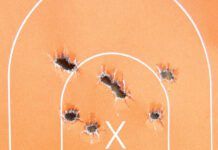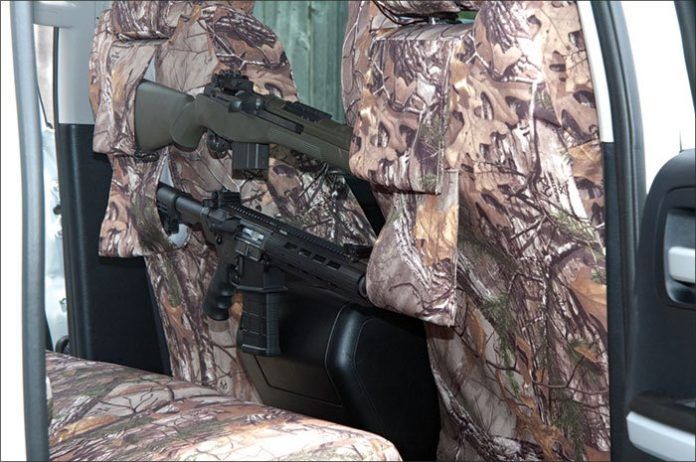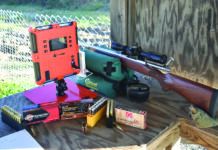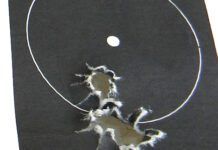If you haven’t noticed, what used to be called the AR-10 platform has made a comeback. Eugene Stoner’s design in 308 Winchester (7.62x51mm NATO) has gone on to unprecedented popularity with military and civilian consumers. But many shooters prefer an even older military-style platform — a compact variation of the M1A rifle, with lineage credited to the John C. Garand M1 rifle. We recently tested two production rifles built on these different platforms, the $2200 Ruger SR-762 and the $1900 Springfield Armory Socom 16, to see which one we’d buy as a handy rifle for self defense, hunting, and all-round fun. Both had barrels around 16 inches long and used gas-piston mechanics to operate.
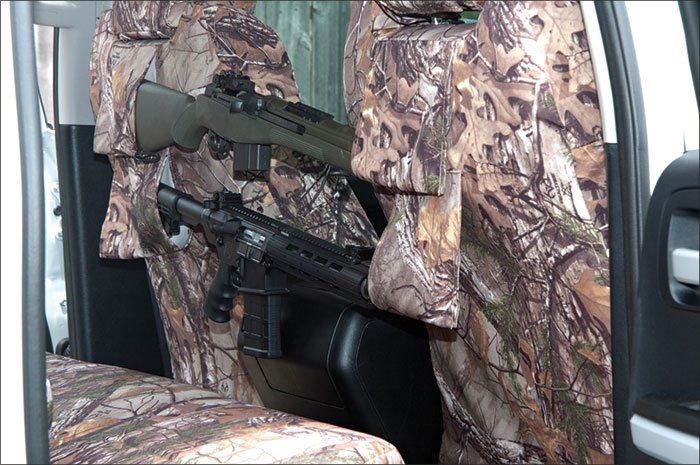
We began by breaking in each rifle using a variety of rounds featuring different bullet weights. We tried two different types of less-expensive 150-grain 7.62×51 NATO jacketed ball ammunition from MagTech and variety of rounds, such as Black Hills 175-grain boattail hollowpoints that have been known to excel in bolt-action rifles. We settled on three Black Hills rounds that shot the best, the company’s 168-grain BTHP, 165-grain Gold Nosler Ballistic Tip, and 155-grain Gold Hornady A-Max ammunition.
For break-in and accuracy shooting, we used the same $310 Leupold FX-II 2.5X28mm IER (extended eye relief) Scout scope No. 58810 on both rifles. That was in part to accommodate the Socom 16, which offered only a short Picatinny rail above the forend. The Ruger SR-762 had a long top rail able to accommodate any type of scope. We could have added a receiver mount to the Socom 16, but, in our view, that would change the platform significantly. For accuracy, we fired five-shot groups from the 100-yard benches at American Shooting Centers in Houston.
Beyond accuracy and reliability we also compared the rifles based on practical handling. This included methods of loading and switching magazines as well as reviewing each gun’s strengths and versatility.

Ruger SR-762 No. 56017.62x51mm NATO/308 Win., $2195
The original version of the Stoner military rifle was chambered for 7.62 NATO and not for 223 Rem./5.56mm. Finding the rifle too heavy in the medium-bore chambering, the military requested chambering in a smaller cartridge that would be easier to carry in bulk and also needed a less substantial receiver. Subsequently, the AR-10 was changed to what became the AR-15, or in its military select-fire version, the M16.
The road back to the 30-caliber AR-10 began when troops fighting in Iraq complained that 223/5.56mm was not providing the stopping power necessary for dealing with drug-enhanced enemy personnel in an urban landscape, where heavily walled structures were common. Several different chamberings have been tried, but the 7.62/308 bests them all as a combination of power, range, economy, and availability. The Ruger SR-762 brings with it not only increased firepower in America’s favorite rifle, but also some significant advancements.

This includes gas-piston operation with a four-way adjustable port, including cutoff for single-shot manual operation. This added versatility makes it a candidate for mounting a suppressor, a feature that characteristically increases operating pressures. There was also a contoured handguard that was ventilated, comfortable in the hand, and easily adapted for attaching accessories such as lights, lasers, a vertical grip, or bipod. There was also a Hogue rubber grip, front and rear flip-up sights, three synthetic-bodied 20-round magazines by MagPul, and a soft-side carrying case.
The flip-up backup iron sights (BUIS) needed to be lifted into position manually. Both front and rear units had spring-loaded left-side release buttons to manually fold them down toward the rear. The rear unit offered a choice of small and large apertures and was windage adjustable from the right-hand side. The Picatinny rail was in three sections atop the gas block, hand guard, and receiver, measuring about 19 inches long in total. The hand guard offered three raised sections at 3 o’clock, 6 o’clock, and 9 o’clock that were smooth for better handling and less interference when working from support. Each of the raised areas was drilled and tapped to attach any or all of the five supplied Picatinny rails. Three 5.85-inch-long rails and two 3-inch-long rails were supplied.
The implementation of a piston-driven operating system offers several advantages over direct gas impingement found more commonly in today’s AR platforms. To a large degree, this system is self cleaning, and it directs heat away from the bolt and the shooter. After 100 rounds of firing, the SR-762’s bolt and lower receiver remained at or near ambient temperature.
Ruger’s system is described as a two-stage design, wherein gas is metered in two successive impulses to the piston. The first impulse is smaller than the second, but with much of the inertia overcome, shock and vibration are reduced. This also spreads recoil sensation over a slightly longer time, creating some perception that the recoil is softer. At the range, we judged the Ruger SR-762 did offer less perceived recoil than the Socom 16. This helped offset the effects of the plastic buttplate — which we thought was an oversight.
The minimal weight and smooth loading of the MagPul magazines seemed to be a plus, but when inserting the magazine below an empty chamber, our habit of palming the magazine to make sure it was seated tended to push it past the proper seating position and prevent the bolt from closing. In our view, the catch lugs on the magazine body did not offer enough detent. A trip to Houston’s Armory Management and Supply Services allowed us try other magazines and confirm that the problem was indeed the supplied magazines and not the SR-762 receiver. Nevertheless, we were able to avoid this problem and complete our tests by foregoing our habitual rap to the bottom of the magazine.
We also learned that the trigger-pull weight was more than 10 pounds. Actually, it began much heavier but did wear in after about 200-plus rounds. Nevertheless, it continued to vary in pull weight and offered a marked duration of creep that made it seem like a two-stage trigger. We could find no information at Ruger.com mentioning a two-stage trigger. Oddly, we adapted to it.
Results from the bench showed the tightest groups were achieved firing the Black Hills Gold 155-grain ammunition, producing the only 1-minute-of-angle group of the test for either rifle. Average group sizes were 1.2 inches, 1.5 inches, and 1.6 inches center to center for the 155-grain, 165-grain, and 168-grain ammunitions, respectively. Head-to-head accuracy between the Ruger SR-762 and the Springfield Armory Socom 16 was a virtual draw.
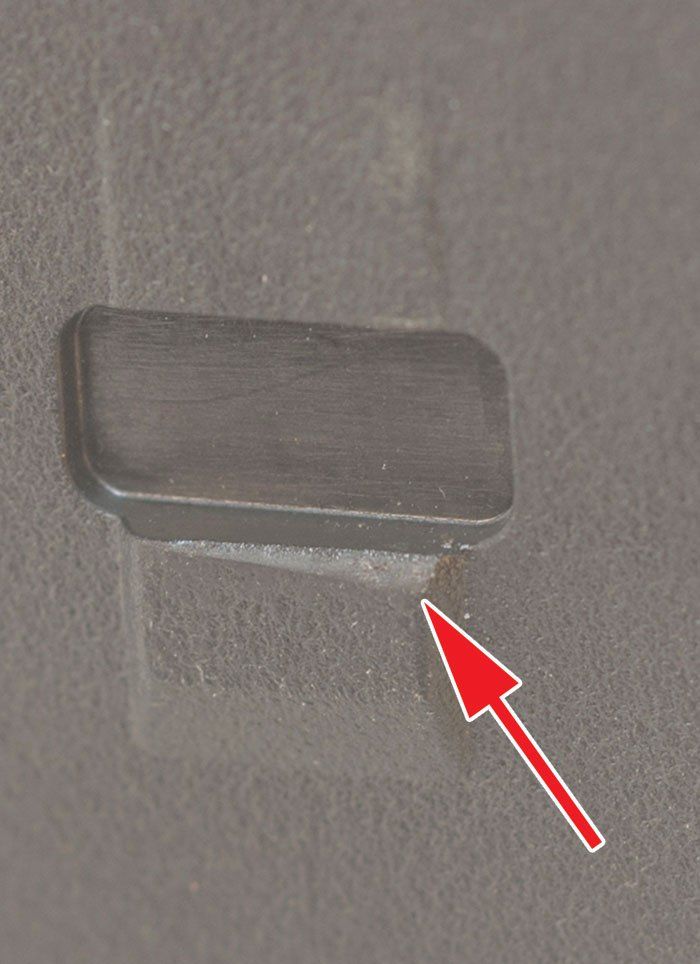
Our Team Said: For most buyers, familiarity with the platform will likely be this rifle’s greatest selling point. Our choice of using a low-power extended-eye-relief scope, rather than taking advantage of the lengthy top rail and mounting a true precision riflescope, likely penalized the Ruger. But, in our opinion, the rough and unnecessarily heavy trigger was likely a greater detriment to accuracy. So if we were to buy this rifle, we would plan on an adding an aftermarket trigger.
Springfield ArmorySocom 16 AA96257.62×51 NATO/308 Win., $1905
The lineage of the Socom 16 goes back to John C. Garand’s design adopted as U.S. Rifle, Caliber .30, M1 by the U.S. Army in 1936. It was invented and perfected at the Springfield Armory in Springfield, Massachusetts. Springfield Armory of Geneseo, Illinois is a separate entity but continues making rifles in this tradition designated the M1A. Of the ten M1A models available, the Socom 16 is a basic carbine offering a 16.25-inch 1:11-twist barrel capped with a muzzle brake with synthetic stock (black or OD green). The front sight is by XS Sights and shows a tritium insert on the 0.125-inch-wide blade sitting between guards that looked more like the horns of a steer than the typical “ears” found on the AR-10 platform. The rear sight was an aperture of more classic M1 design. The aperture rode between protective stanchions, on which were mounted a 1-moa-per-click elevation-adjustment dial on the left and a 1-moa-per-click windage-adjustment dial on the right-hand side of the unit.
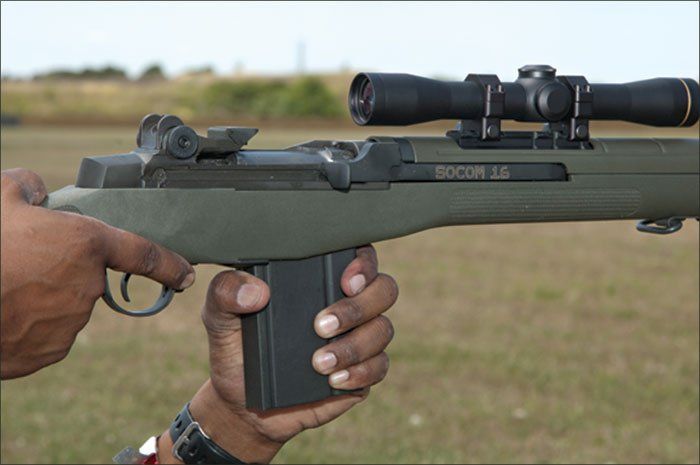
The OD Green synthetic stock may not be traditional, but the hinged steel buttplate was. Swinging the plate upward exposed an access door revealing two cylindrical chambers for storing cleaning supplies and tools. These days, you could store batteries for a weapons light or even add ballast to change the balance of the rifle. We couldn’t help but notice that a rubber buttpad was an option on several other M1A models. The rubber buttpad (No. MA6107SA) is sold separately for $52, and we’d definitely add it to the Socom.
The Socom 16 comes fit with a 4-inch-long Picatinny rail well forward of the receiver above the forend. The whole idea of a carbine is to be compact, and that’s one reason why we declined to mount one of Springfield Armory’s 4th Generation scope mounts, even though it would have allowed us to use any riflescope of our choosing. An aluminum mount sells for $125, the steel version costs $300. We tried a variety of red-dot reflex sights on the Socom, but without adding material to the stock comb, our shooters said the resulting head position was too high for optimum control. Instead, we fired with the Leupold fixed-power scout scope because it afforded us a tight cheek weld with the lowest possible mount.
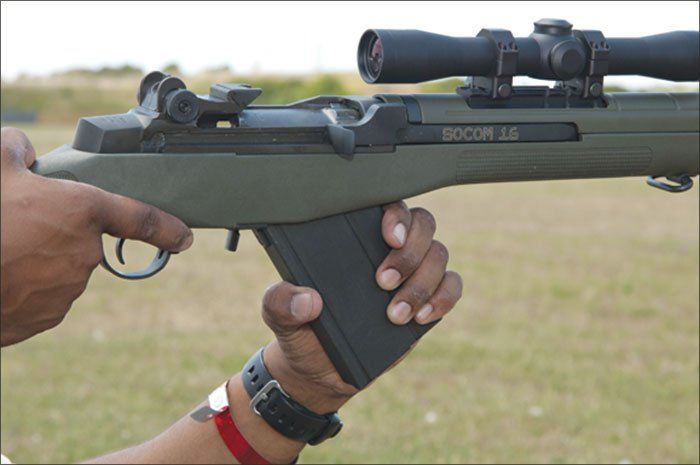
Despite modest innovations, much of the Socom 16 remains true to its M1 battle-rifle heritage, and in light of this, comparison to the SR-762’s AR-10 history, several of the Socom’s operational features demanded reevaluation. The charging handle was right side only with a manual catch on the left side to keep the bolt open. Perhaps the thinking at the time (in between World Wars I and II) was that this would not interfere with the habit of working a manual bolt with a support hand beneath the forend. Left-hand shooters will need to pull the stock into the shoulder while pulling back the bolt. Otherwise, the stock was neutral in terms of cast, and the pistol grip lacked excessive palm swell on either side. With greater stability thanks to its pistol grip and ambidextrous access to the changing handle, in our view the AR wins in this regard.
The safety was ambidextrous, but it required the trigger finger to push it rearward into the circumference of the trigger guard as close as 0.65 inches from the face of the trigger. Safety-off means putting the finger inside the trigger guard and pushing it forward. The trigger is a two-stage design with a firm take up followed by a second stage of 5.75 pounds of additional pressure. Actually, the trigger felt heavier, but it offered a smooth, even travel start to finish. The Socom trigger pull did not need to be lightened to enhance precision. Safe operation depended on familiarity and operator integrity.
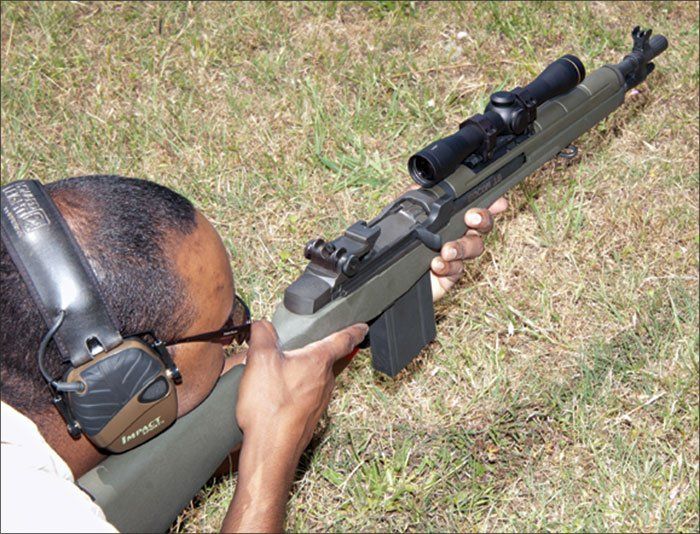
Both the Ruger and Springfield magazines loaded easily. Neither could be single loaded by throwing in a round and shutting the bolt. But the Socom 16 magazine can be loaded through the ejection port with the bolt locked back. And the guide for a stripper clip was still in place. The Socom 16 arrived with one 10-round magazine and one 20-round magazine. We think top loading would likely be more appropriate for the 10-round magazine, not just because of its lesser capacity but also for its shorter profile. Naturally, this magazine made the gun smaller top to bottom and more convenient to shoot from support, but it was more difficult to grasp. To release the magazine, the shooter pressed the vertical lever at the rear of the magazine well. This motion was integrated with a natural grasp of the magazine, with thumb at the rear compressing the release while rotating the magazine forward and down. The motion and grip were the same when using either the left or right hand. The longer 20-round magazines were easier to remove because their length offers a better grip with the inside of the thumb naturally indexed upon the release lever. Inserting the magazine was just the opposite, leading with the forward edge of the magazine at about a 30-degree angle to the receiver rotating it into place.
We found reloading the AR-10 was faster and easier in only one situation. If you release the AR-10 magazine and are willing to let it fall, then another magazine can be in place almost before the empty magazine hits the ground. If you intend to retain the empty magazine, then it’s a tie because in each case you must grab the magazine upon release and place it in a pocket or pouch. Be aware that the AR style may allow the magazine to shoot out of the receiver before you are ready. Ejecting the M1A magazines requires that you grasp and control it.
The Socom 16 gas system did not offer adjustability. This means that adapting a suppressor would not be as simple as on the Ruger. While Ruger puts its two-stage piston action front and center, the Socom 16 works with a delay of its own. The delay before the bolt is released was built in for safety and not necessarily to address recoil. Indeed almost every self-loader operates with a delay of some kind to make sure the cartridge case does not back out of the chamber while under pressure and rupture for lack of support. In the M1A design, the bullet is gone before the bolt unlocks. Recoil was a softer push than we expected, but we judged the Socom 16 to transmit slightly greater recoil than the Ruger SR-762.
Our Team Said: What the data do not show was that the Socom 16 was a ball to shoot. And if you cannot tell from the photos, this weapon was built like the proverbial brick you-know-what. If we were looking for a truck gun or other handy application, we think the Socom 16 is the deluxe model for chores that require stopping power. Top to bottom, the rifle is truly compact (more so with the smaller magazines) and throwing the Socom 16 to the cheek and shoulder was as fast as it was pleasing.
Written and photographed by Roger Eckstine, usingevaluations from Gun Tests team testers.



